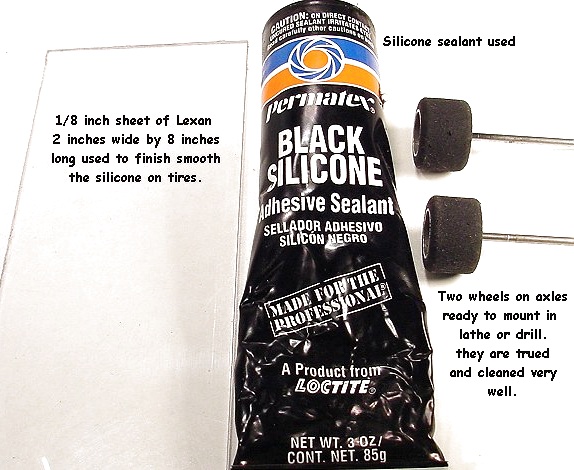Silongies you ask? Silicone coated sponge tires or spongilies. whatever. I did this type of tire back in the middle 60’s. And again in the late 80’s for a short time. They worked well for a time in the 60’s till the super sticky sponge tires became the standard fare and I stopped making the silicone sponge tires as I got tired of keeping up, doing them, only by myself locally. And the new sponge tires were at that time quicker and cheaper. Cars were quicker and in 1/24th scale the coated tires could not keep up. But now in 1/32nd scale with our lower power motors and smaller tracks, such as at home or small 4-6 lane commercial tracks they seem to work well again, such as at the Marconi proxy. So for those who would like to try making you own, here is a quick article on how I make them for my own use.
I use them mainly to make wider tires than are available other than by special order from the silicone tire makers. I like as wide a tire as I can get to suit my needs. I use old worn down sponge tires with the big and full hubs such as made by JK, HTK, Or Alpha on my 1/24th cars. This gives me at least a .450 inside diameter for inserts. I like them worn down to about .750 for rears or trimmed down to that size. adjust for your needs by trimming. I make them about .030-040 smaller than the desired finished size. That allows about a .030-.040 coat of silicone. I have found this brand of silicone to work the best so far. Permatex black silicone sealant available in 3oz tubes at the local auto parts store.
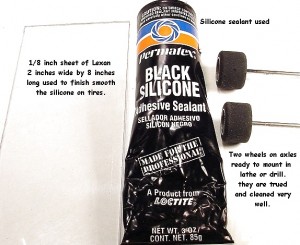 I prepare the tires by truing to exact size on a tire truer of commercial or home made type, or a hand held drill motor and sand paper block. When truing, make sure they have a true tire shape with rounded sidewalls and a rounded edge to resist grabbing the slot or braid in corners. It also makes the silicone stick to the tire better and resist peeling at the edges. Very important point in keeping them intact for awhile while racing them. After truing them up, now you must clean them very well. I use lighter fluid and a clean rag. Wet them down several times and wipe off any truing dust or tire goop material, so the rag shows clean when done. I prepare the tires by truing to exact size on a tire truer of commercial or home made type, or a hand held drill motor and sand paper block. When truing, make sure they have a true tire shape with rounded sidewalls and a rounded edge to resist grabbing the slot or braid in corners. It also makes the silicone stick to the tire better and resist peeling at the edges. Very important point in keeping them intact for awhile while racing them. After truing them up, now you must clean them very well. I use lighter fluid and a clean rag. Wet them down several times and wipe off any truing dust or tire goop material, so the rag shows clean when done.
Mount them on a spare axle near the end so you can easily grip them by the axle with out touching the tire. Mount the tire and axle in a lathe chuck or use a small drill press or hand held drill motor, held in a vise to have control, of how they get worked on. Make sure the motor does not spin them too fast or you will not get the silicone to stick and get some thrown off in your face, (messy).
Once mounted in the chuck, open the tube of silicone, and with a clean dry finger apply a 1/4 inch long ribbon of the silicone as it comes out of the tube to your finger and then rub it in vigourosly into the tire surface working the first coat in firmly to get seated it into the tire surface completely. It will take at least 3 to 4 applications of the same size amount of silicone to coat the tire well enough to build up a coating of at least .030 -040 to come to the desired diameter of the tire.
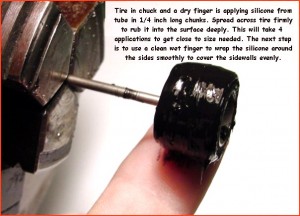 When all coats are applied, clean your finger off well. I recommend a finger whetted with spit (water) to be applied to the tire surface to work the silicone now on the tire surface, into a smooth and complete coating. Especially working it down around the sidewalls to the rim. Make sure the sidewalls have a good coating front and rear. When all coats are applied, clean your finger off well. I recommend a finger whetted with spit (water) to be applied to the tire surface to work the silicone now on the tire surface, into a smooth and complete coating. Especially working it down around the sidewalls to the rim. Make sure the sidewalls have a good coating front and rear.
The spit or water will keep it from sticking to your finger, so it can move the silicone around where you want it. When it looks good to you. Stop and get out a smooth flat surface such as the recommended, Lexan sheet, 1/8 inch thick by at least 6-8 inches long. A piece of glass or a mirror will work as well. The sheet is then wet with water or (spit) and applied to the tire surface either by bracing the bottom side against the nearest hard surface, or as I prefer just hand hold it against the tire surface and lightly press against the tire to make a good true flat surface. If your press too hard, you will run the silicone over the edge too far and have to work it back to the center again. This will take some practice to get it the way it looks best. If you get a sharp edge, wet your finger again and work the sharp edge back to the middle and use the sheet again to flatten and true again.
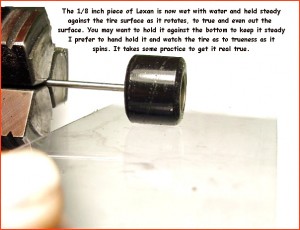 Once it looks right and true, watch the run-out, remove the axle and wheel from the chuck with out touching the tire. Place the axle end, in an upright position in a hole drilled in a block of wood so it will stand, up right by it self. Then when both or as many as you have done, are mounted in enough holes, place the block of wood under a 60 watt lamp to warm them up for at least 3 hours to dry the silicone out. When dry, you can true the tire up, or just run them in. I find as I get practice at it I can get my tires to with .010 of the same diameter easily. Then it is only a matter of a light sanding to even the diameters out close enough for racing purposes. Many of them are ready to run right after drying and just a few laps of track time will true them right up. Once it looks right and true, watch the run-out, remove the axle and wheel from the chuck with out touching the tire. Place the axle end, in an upright position in a hole drilled in a block of wood so it will stand, up right by it self. Then when both or as many as you have done, are mounted in enough holes, place the block of wood under a 60 watt lamp to warm them up for at least 3 hours to dry the silicone out. When dry, you can true the tire up, or just run them in. I find as I get practice at it I can get my tires to with .010 of the same diameter easily. Then it is only a matter of a light sanding to even the diameters out close enough for racing purposes. Many of them are ready to run right after drying and just a few laps of track time will true them right up.
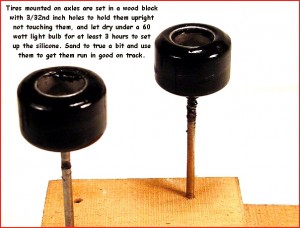 I realize this is quick and dirty, so if you have questions please ask and we will try to give an answer. It looks easy but does take some practice. Don’t attempt this on wheels with inserts as the silicone will tend to wrap around the sidewalls and get into the inserts and get messy. On plain wheels it is easy to clean it out and then add the inserts after. Lucks of luck, I have some of these tires still around and usable from some I made in the middle 80’s. The silicone tens to seal the sponge rubber from the air and does not allow it to dry out as it normally does. They stay soft for quite a while while fully coated. I realize this is quick and dirty, so if you have questions please ask and we will try to give an answer. It looks easy but does take some practice. Don’t attempt this on wheels with inserts as the silicone will tend to wrap around the sidewalls and get into the inserts and get messy. On plain wheels it is easy to clean it out and then add the inserts after. Lucks of luck, I have some of these tires still around and usable from some I made in the middle 80’s. The silicone tens to seal the sponge rubber from the air and does not allow it to dry out as it normally does. They stay soft for quite a while while fully coated.
by Larry Shephard
|
